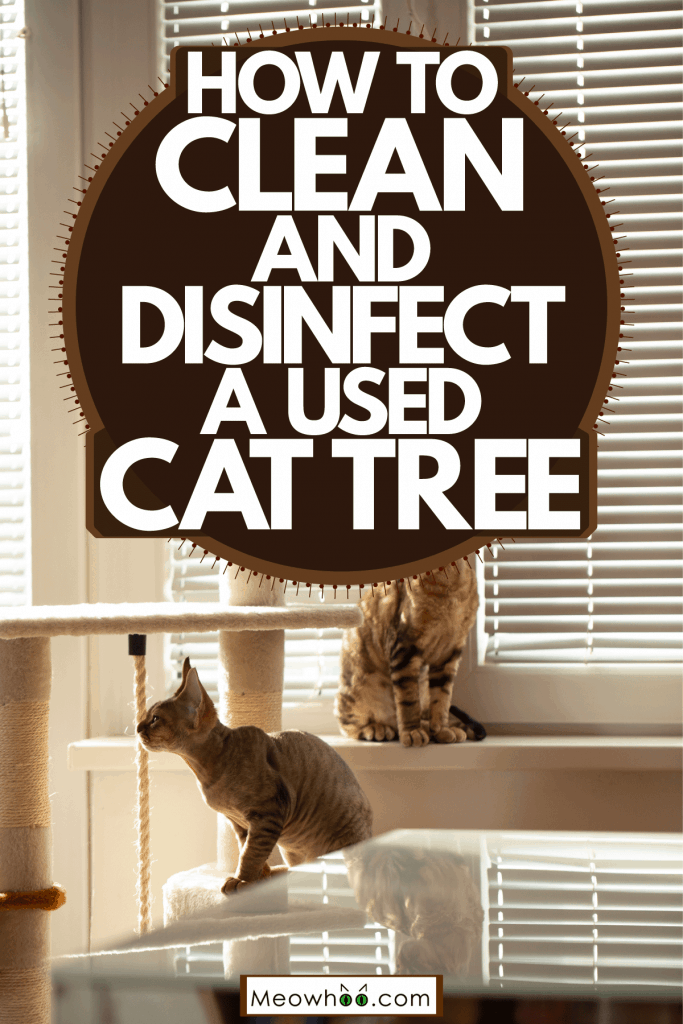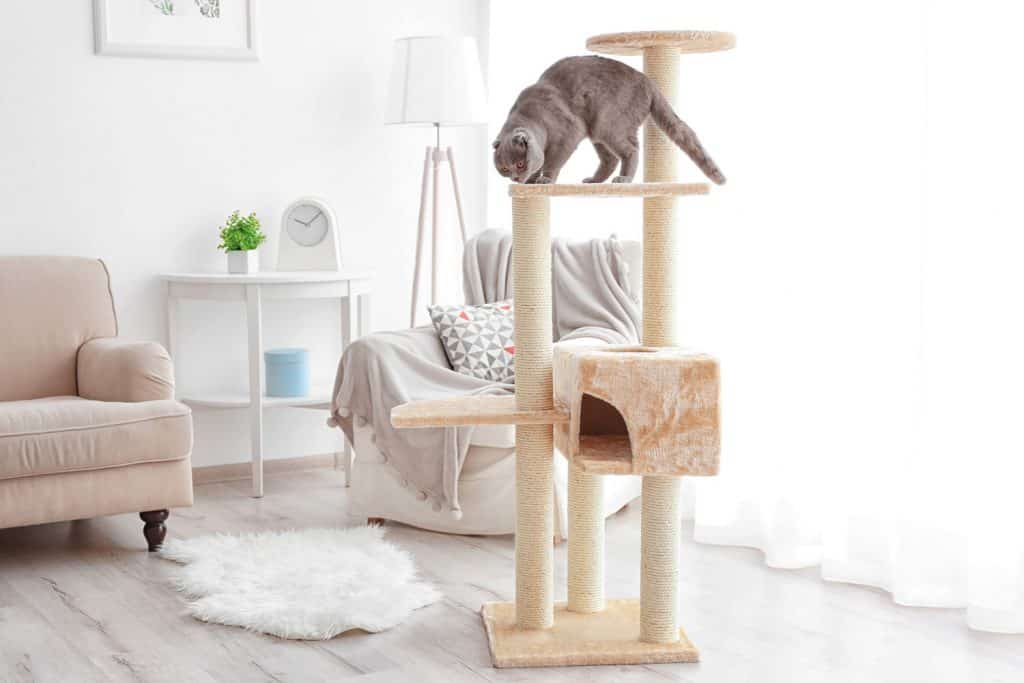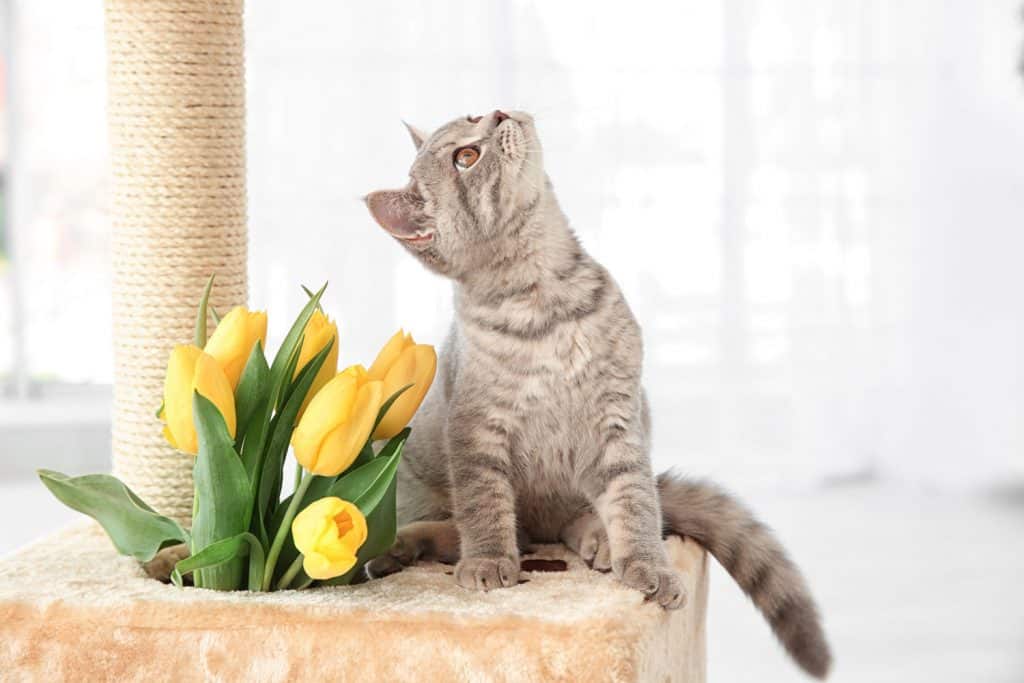Cleaning and disinfecting a cat tree is a must for relatively every cat parent. This need grows when you buy a used cat tree because you don’t know how the previous owner took care of the item. Now you're wondering, how to clean and disinfect a used cat tree? We already researched the cleaning and sanitizing of cat trees by probing feline experts to provide the correct answer for you.
Cleaning and disinfecting a cat tree requires tools like a vacuum cleaner, a scrub brush, an old comb, a de-shedding tool, and pet-friendly cleaning solutions. Once you have the necessary items, removing dirt and other filthy substances from the cat tree can be done with the following steps:
- Remove remnants of cat fur from the tree with a scrub brush and an old comb.
- Use a de-shedding tool to remove matted fur.
- Apply a mixture of lukewarm water and hydrogen peroxide.
- Use a vacuum cleaner to remove leftovers of fur, dust, dirt, and other types of filth on the cat tree.
The entire process might look simple at first. However, missing steps can increase your pet’s risks of contracting illness from the unclean substances left behind. Continue reading to understand the details of cleaning and disinfecting a used cat tree for your feline's well-being.

How Do You Deep Clean a Cat Tree?
You need to deep clean a cat tree frequently, regardless of the status of its usage. For example, you purchased an old, yet still usable cat tree from an animal shelter. According to a study from the European Advisory Board on Cat Diseases (ABCD), infectious diseases can be difficult to control and prevent in shelters. Therefore, if you don’t clean the used cat tree, your housecat will be at a higher than average risk of contracting illnesses.

Here are the steps to help you deep clean your cat tree:
1. Remove the Fur
You’ll likely see fur dangling on the carpets of a second-hand cat tree. At this point, you have two options: First, replace the cat carpets with new models, and second, remove the fur from the tree using common household cleaning items.
If you choose the second option, start the process by using a scrub brush and an old comb to remove the fur from the dirty tree. Brush every carpeted surface on the tree. Also, don’t disregard the scratching posts during this step. Make sure to get all the sides, including the tree’s base.
If the cat tree is over 7-feet tall, it should be reasonably sturdy for you to lean against it. Otherwise, don’t attempt to put your weight on a small cat tree or you’ll damage the product.
Check out this 9-foot PawHut Vertical Cat Tree on Amazon.
2. De-Shed the Carpets
After removing most of the cat hair from the carpets and posts, you may notice that some of the furs are still stuck on the surfaces. This feline hair is matted, which means a thick, entangled mass as per the word's description.
Don’t forcefully remove the matted fur with your scrub brush and old comb. If you do so, you’ll damage the carpets and posts, leaving unsightly bald spots if you’re not careful. Instead, use a de-shedding brush for this step. This tool should get most of the matted fur out of the cat tree.
Again, don’t forget to tackle all the sides of the tree and its base. Put the removed matted fur to one side. You may also use a pail or bucket for easy disposal.

Look at this DakPets De-Shedding Brush on Amazon.
3. Kill the Germs and Harmful Bacteria
A used cat tree can harbor germs and harmful bacteria from its previous owner. Additionally, these unclean substances can leave off-putting stenches.
To remove germs and bacteria on the used cat tree, start by spraying clean paper towels with a pet-friendly odor remover and place them generously on the cat tree. Then, create a solution made of 3% hydrogen peroxide and lukewarm water. Place the mixture in a spray bottle and spray the liquid all over the cat tree. This solution should do a reasonably good job in killing different unclean substances on the tree’s surfaces.
Wait for about 5 minutes before removing the paper towels. Take note that you shouldn't let your cat get on the cat tree while the towels are still drying. It's because hydrogen peroxide, along with other cleaning solutions like alcohol and bleach, is harmful to felines, as per a post from The Humane Society of the United States.
After removing the paper towels with the hydrogen peroxide solution, use another set of clean towels to remove excess moisture from the cat tree. You’ll know if the solution did fairly well if you see residue like dirt and litter on the towels.
At this point, you may continue to spray the hydrogen peroxide solution on the cat tree. But make sure that your cat is out of the immediate area or the animal may show signs of discomfort from the chemical.
4. Final Touches
You may stop after disinfecting the cat tree. But you can proceed by using a vacuum cleaner to give the cat tree a thorough clean. By the time you finish, your cat can now enjoy a tree that doesn’t look like it had a previous owner.
Which Disinfectant is Safe for Cats?
Natural cleaning products, such as those that contain citric acid, white vinegar, and bicarbonate soda are reasonably safe to use around cats. Avoid using solutions with harsh chemicals like phenol chloroxylenol because these can cause a harmful reaction to felines and other pets.
How Do You Get Cat Smell Out of Cat Tree?

Aside from using a natural store-bought deodorizer for surfaces, you can also use a baking soda and vinegar mixture in a spray bottle to remove off-putting smells on cat trees. Vinegar is an acid, which helps neutralize the alkaline salts that might be present in certain stench-causing bacteria. With the help of baking soda, the solution can help remove both harmful bacteria and the foul smell they produce.
How Do You Get Hair Off a Cat Tree?
You can use an old comb or a de-shedding brush to remove hair from a cat tree. Additionally, you can use a pet hair-removing roller. Take note that some of the hairs might be tougher to remove than others. Therefore, it can take multiple passes with your chosen tool to remove the cat hair from the tree.

Check out this Nova Multi-Level Cat Tree Tower on Amazon.
Is It Safe To Buy a Used Cat Tree?
Generally, buying a second-hand cat tree isn’t a good idea. The used product can introduce unwanted stress, illness, and even behavioral issues to your feline. Furthermore, your pet may leave the tree alone if the product had a previous owner. It’s because another cat marked the tree and its surfaces, making it the other animal’s territory.
Also, the cat tree’s poles might have some leftover catnip from the previous owner. If you don’t remove the catnip, it’ll desensitize your feline from the substance, making it tougher than average to train your pet to do certain actions.
Final Words
Clean and disinfect used cat trees by removing leftover hair with a brush or comb. Then, disinfect the surfaces with a water and hydrogen peroxide solution, along with several paper towels. You may also vacuum the surfaces of cat trees to remove excess residue. However, consider buying a new cat tree instead of a second-hand one to reduce health risks for your feline.
Some elements on this page may have been created by our team using advanced AI to provide you with top-notch cat inspired ideas. Read more about our AI Content Policy.


The cleaning methods I found online either weren’t sufficient enough or were way over the top. (Like I’m going to dismantle a 7’- 6 tiered cat tree) The cat tree(s) I’ll be cleaning aren’t used but they are a year old and really need a good cleaning and disinfecting. This article touched base on all the concerns I had and it is 100% doable. Noah & Finn thank you. 😺😺
I bought a used cat tower and did all the recommended steps I even sprinkled with baking soda and used a vacuum to clean it off. The tower has no foul smell and looked clean when I bought it but even after hydrogen peroxide and baking soda and everything my cat still refuses to go in it. Any advice would be appreciated.